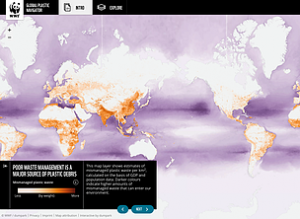Global interactive map reveals marine plastic pollution
(Source: WWF-VIET NAM)
Plastic pollution is one of the largest environmental problems in the world. Today, WWF – World Wild Fund for Nature – launched a new, free-of-charge interactive map on the website plasticnavigator.wwf.de, turning the spotlight on marine plastic pollution. The Global Plastic Navigator shows which countries contribute the most waste to the environment, which rivers deliver the most waste to the oceans and the concentration of plastic at the sea surface. “The map turns the latest scientific data into a visual tool. This helps give people a clear idea of the size of the huge flood of plastic waste – both from the global perspective of the world’s oceans to smaller, local sources of plastic pollution that comes from individual rivers. The result is frightening: there is plastic even in the furthest reaches of our oceans.”, explains Bernhard Bauske, the project coordinator.

Global Plastic Navigator on web plasticnavigator.wwf.de
WWF is calling for an international agreement to end the flood of plastic waste. The Global Plastic Navigator shows which countries have already publicly spoken out in favour of such an agreement, including member states of the European Union (EU) and the African Union. “Thanks to the map, we can see that support for an international agreement against the discharge of plastic waste into the oceans is already quite strong”, says Bauske. “With the interactive map, every citizen can now see whether their government is committed to this framework against marine plastic. This will also increase the pressure on states that are still hesitant about the agreement”.
Stop the flood of plastic waste
The flood of plastic waste in oceans is a global crisis and only international cooperation can tackle the challenge. WWF is therefore campaigning for an international plastics agreement to create legally binding regulations on plastic waste reduction and improved plastic management. As a result of this agreement, waste management is improved in many countries – along with positive impacts on people and the environment.
In Viet Nam, the volume of waste surged to over 31 million tons of domestic waste and nearly 5 million tons of plastic waste1 in 2018. After collection, only a small proportion of waste is sorted and recycled, 60 – 70% is buried in unsanitary landfills, or even dumped directly into the environment1. With about 0.28-0.73 million tons of plastic waste being leaked into the oceans each year2, Viet Nam is one of the countries contributing the most to marine plastic pollution.
Recently, Viet Nam has made efforts to improve the legal framework and set out specific plans including National Strategy for Integrated Solid Waste Management to 2025, with a vision to 2050; National Action Plan for Marine Plastic Debris Management in Viet Nam by 2030; National Action Plan for Sustainable Production and Consumption, etc. However, the minimisation of marine plastic debris is not a challenge that government policies can tackle alone. It requires the cooperation of the society as a whole, including behaviour change, sustainability training and enterprise engagement to fight against increasingly widespread “white pollution” in Viet Nam.
As one of the first international NGOs in Viet Nam, WWF-Viet Nam has been working hard to implement projects and programs to solve plastic waste pollution, including Phu Quoc: Towards a Plastic Waste-Free Island project, Plastic Smart City project (NORAD), A community with no plastic waste program, Plastic Waste Management in Long An project, Plastic Smart City – Hue project and Mitigating Marine Plastic Debris project in collaboration with the Ministry of Natural Resources and Environment.
____
(1): World Bank, 2018
(2): Jambeck et al., 2015

